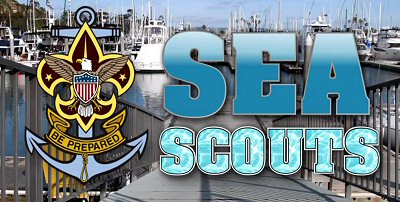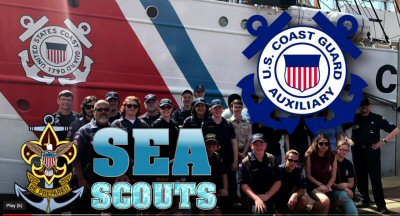Sea Scouts
| Sea Scouting is the Coast Guard Auxiliary's official youth program and is a Boy Scouts of America program for young men and women, ages 14 (or 13 years of age and completed eighth grade) through 20. Sea Scouts provide a program for religious, fraternal, educational, and other community organizations to use for effective character, citizenship, and mental and personal fitness training for youth. As part of this training, Sea Scouts are expected to develop personal religious values, learn the principles of American heritage and government, and acquire skills that will prepare them to become successful adults. The advancement scheme for Sea Scouts places an initial emphasis on nautical skills before encouraging the youth to take a major role in planning activities in the unit. Young men and women ages fourteen through twenty who are willing to abide by the requirements of BSA membership, including agreeing to live by the ideals expressed in the Scout Oath and Law and Sea Promise are eligible to join a Sea Scout Ship. Ships are administered by volunteers with the assistance and support of some paid professional staff. Any Sea Scout who is at least 14 years old or Sea Scout leader may also choose to become full members of the U.S. Coast Guard Auxiliary by following the normal application process. We also participate in a program to recognize all BSA Eagle Scouts, Venturing Summit Award recipients and Sea Scout Quartermasters as well as Girl Scout Gold Award holders. See their respective pages for more information. The national Auxiliary-Sea Scout Youth Development (AUXSCOUT) Program Standard Operating Procedures (revised 21 OCT 22) outlines how Auxiliarists are to work with Sea Scout youth and adult members, whether or not they are also Coast Guard Auxiliarists. National program oversight is provided by the Auxiliary's Youth Programs Division. All Auxiliary Districts have District Staff Officers - AuxScout (DSO-AS), most divisions have Staff Officers - AuxScout (SO-AS), and flotillas that have direct, sustained, and constructive engagement with a counterpart Sea Scout Ship have Flotilla Staff Officers for the AuxScout Program (FSO-AS). Organization support details and job descriptions for Auxscout are available on AuxBWiki. Answers to Frequently Asked Questions are available HERE]. Any questions not answered on AuxBWiki or the SOP may be directed as follows: * Questions from District Commodores and District Chiefs of Staff should be directed to Bruce Johnson, Youth Programs Division Chief, DVC-SY * Questions from all others in D1N, D1S, D5N, D5S, D7 should be directed to Arnie Geller, BC-SYA. Be sure to copy your DSO-AS and DCOS on your email. * Questions from all others in D8C, D8E, D8W, D9C, D9E, D9WR should be directed to Bart Knapp, BC-SYW. Be sure to copy your DSO-AS and DCOS on your email. * Questions from all others in D11N, D11S, D13, D14, D17 should be directed to John-Michael Zimmerle, BC-SYP. Be sure to copy your DSO-AS and DCOS on your email. * Questions about starting a Sea Scout Ship should be directed to Mike McBride, BA-SYSA. |
Contents
|
Auxiliary Policy links
- Memorandum of Agreement among the Coast Guard Auxiliary, the Boy Scouts of America, and the Coast Guard Auxiliary Association
- Standard Operating Procedures
- Executive Summary
Up-coming online workshops
- 1/8/23 – AUXSCOUT Staff Officer Training - link will be provided soon - Workshop starts at 2030 Eastern
- 2/??/23 – AUXSCOUT workshop: topic to be announced
- 3/??/23 – AUXSCOUT workshop: topic to be announced
Most workshops begin at 2100 Eastern / 2000 Central / 1900 Mountain / 1800 Pacific / 1700 Alaska / 1500 Hawaii time and are scheduled to last about 1 hour. There are no advance sign-ups, and attendance is limited to 100 participants per session. Click the link above to log into the live session.
Stay current
- Join the Sea Scouts, the Coast Guard Auxiliary's Official Youth Program Facebook group
- Subscribe to the AuxScout YouTube channel
- Check out the article on "How Sea Scouting Benefits the Auxiliary" in the 1st Quarter 2023 Navigator Express.
Day-one questions
 
|
| AuxScout Facebook group & YouTube channel |
For Auxiliarists
- What should my district be doing to get started?
- What should my division be doing to get started?
- What choices does my flotilla have for supporting Sea Scouts?
- What does my flotilla or division need to do to organize a Sea Scout Ship?
For Sea Scouts
- What should my council be doing to work with the local Auxiliary?
- What support can my Sea Scout Ship get from the Auxiliary?
Available AuxScout Training
Coast Guard Auxiliary Best Practices
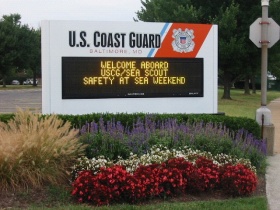
|
| The Coast Guard & Coast Guard Auxiliary host Safety at Sea training events all over the country |
- Auxiliary-Sea Scout Frequently Asked Questions
- Sea Scouts BSA - Auxiliary Youth Leadership Program Organizational Support
- Checklist for AuxScout Involvement
- Checklist for organizing a new Sea Scout Ship (posted 04Oct2022).
- AUXSCOUT Marketing and Media Relations Toolkit
- Chartering a Sea Scout Ship
- Sea Scouts BSA - Auxiliary Youth Leadership Program Organizational Support
- AUXSCOUT Science - Technology - Engineering - Mathematics (STEM) Toolkit
- Safety at Sea Weekend -- Weekend on-the-water training event held jointly with the Coast Guard and Coast Guard Auxiliary
- Providing Shoreside and Underway Training Opportunities to Sea Scouts
- Auxiliary University Programs
- Academy Introduction Mission (AIM)
- Academy Introduction Mission (AIM) -- Introduce Sea Scouts to the U.S. Coast Guard Academy
- Coast Guard Mutual Assistance Education grants
- U.S. Coast Guard Academy Admissions Partners
- Auxiliary Youth Programs
- Providing Shoreside and Underway Training Opportunities to Sea Scouts
- Sea Scout Advancement - Coast Guard Auxiliary training crosswalk
- Preparing for a Trip to the Florida Sea Base
- Canoeing and Kayaking
- Coast Guard Auxiliary Boater Education for Scouts
- Eagle and Quartermaster Recognition
- Merit Badge Counseling
- Vessel Safety Checks of Sea Scout boats
Aims and principles
- Sea Promise
As a Sea Scout, I promise to do my best
To guard against water accidents;
To know the location and proper use of the lifesaving devices on every boat I board;
To be prepared to render aid to those in need;
To let those less able come first.
- Mission
To develop, enhance, and expand the Sea Scouts, BSA program in a manner that emphasizes the purposes and achieves the objectives of the Boy Scouts of America, working to help local councils improve their membership and programs.
Sea Scouts also learn and subscribe to the Scout Oath and Scout Law.
Organization

|
The ship is the fundamental unit of Sea Scouting, consisting of five or more Sea Scouts and the adult leaders. Ships are numbered and may adopt a name.
Each ship is sponsored by a community organization such as a business, service organization, private school, labor group or religious institution. The chartered organization is responsible for providing a meeting place and promoting a good program. A chartered organization representative manages the relationship between the ship, the chartered organization, and the BSA.
The ship committee is a group of adults, led by the ship committee chair, who guide the ship program and activities and manage record keeping, finance, leadership recruitment and registration. The ship is led by youths who are elected to the positions of boatswain, boatswain's mate, crew leader, assistant crew leader, yeoman, purser, and storekeeper. Skipper and mate provide guidance while allowing the youth to lead the ship.
Above the level of the Ship, BSA has local Councils, National Service Territories, and the National Committee. A council may have one or more Sea Scout Ships. If there are enough Ships, the council has a Council Sea Scout Committee which holds regattas, training days, events, long cruises, leadership development training, multi-Ship sails and barbecues, and much more. Several councils in a geographic area are supported by a BSA “National Service Territory" (NST or Territory) which have a Territory Commodore and Territory Boatswain (top youth member) and are multi-state in size and scope. NSTs hold regattas, rendezvous, training weekends, safety-at-sea events, long cruises, Sea Scout advancement academies, and other events.
The National Sea Scout Committee’s (NSSC) mission is to develop, enhance, and expand the Sea Scout program in a manner that emphasizes the Boy Scouts of America’s purposes. Committee members are appointed by the National Sea Scout Commodore upon approval of the individual’s council. The Committee selects a National Boatswain annually from among the youth members who apply with the approval of the individual’s council. Territory Commodores serve as ex officio members of the committee. The committee is made up of six action groups: Communications & Technology, Ship Growth & Retention, Marketing, Operations & Administration, Program Support, and Relationships.
Advancement

|
| Ranks: Apprentice, Able, Ordinary, Quartermaster |
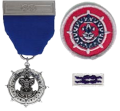
|
| Quartermaster Award medal, badge and knot |
The Sea Scout rank system consists of Apprentice, Ordinary, Able, and Quartermaster. The first rank of Apprentice shows basic marlinspike seamanship skills, safety and basic ideals. To earn Ordinary, the Sea Scout must know, the Ideals of Sea Scouting, be an active member for six months, learn specials skills relating to boats, marlinspike seamanship, piloting, communicating, swimming, safety, and cooking. In addition three of seven electives need to be completed such as, close order drill, signaling in semaphore, boxing a compass, yacht racing, sailing, ornamental ropework, and engine maintenance. For the Able rank, the Sea Scout must be able to explain and demonstrate a complete knowledge seamanship skills, earn the Lifesaving merit badge, complete a long cruise, and must and be a petty officer in his or her ship.
Quartermaster is the highest rank attainable by a Sea Scout can earn and is equivalent to Eagle Scout. The Sea Scout must attend at least three quarters of all Ship meetings and special activities over eighteen months, demonstrate marlinspike seamanship and leadership skills, demonstrate the ability to teach Sea Scouting skills, complete a Quartermaster Leadership Service Project (community service project) and pass a council level bridge of review. The Quartermaster emblem is a medal consisting of the Sea Scout emblem on a ship's wheel that is suspended from a solid dark blue ribbon that is in turn suspended from a bar bearing the design of a double carrick bend knot.
Sea Scouts who earn this rank are entitled to wear a uniform similar to that of a United States Navy Chief Petty Officer (CPO), and can earn advanced rates upon enlistment into the U.S. Navy or United States Coast Guard.
See also Providing Shoreside and Underway Training Opportunities to Sea Scouts
See also Sea Scout Advancement - Coast Guard Auxiliary training crosswalk
Other awards and recognitions
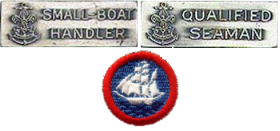
|
| Small Boat Handler, Qualified Seaman, Long Cruise Badge |
Sea Scouts may also obtain the boating licenses and safe boating training certifications offered at the state and local levels and are encouraged to qualify in first aid, CPR, lifesaving, SCUBA and US Sailing certifications. The Long Cruise Badge may be earned by Ordinary rank and above Sea Scouts and adults who complete a two week cruise, or a series of weekend or overnight cruises adding up to 14 days. Segments indicate subsequent awards— red for one additional award and white for five additional awards.
Sea Scouts who have earned the First Class rank in Scouts BSA can work on requirements and merit badges for the rank of Eagle Scout until age 18.
Activities
As a nautical program, most ships engage in several activities in this area, such as sailing trips, scuba dives, and other boating activities. Ships also maintain their boats and equipment.
Councils with a squadron structure may hold Sea Scout regattas or rendezvous organized among local ships, often with sailing competitions that may include ships from other councils. Several areas and regions organize similar events. Some areas and regional also organize training events like Safety at Sea Weekends and Winter Training Weekends. There is no National Sea Scout event, but the biannual William I. Koch International Sea Scout Cup, is an international Sea Scouting event.
Training
| Sea Scout Advanced Leadership SEAL |
Youth Training
Sea Scouts, BSA offers a wide variety of training and education programs designed to enhance your Sea Scout experience. Youth may attend the week-long Sea Scout Advanced Leadership Training (SEAL) Upon completion, the double-dolphin SEAL training pin may be worn. The Sea Scout Training & Education page on the Sea Scouts BSA website provides the details.
Adult Training

|
| Seabadge Trident pin |
Sea Scouts, BSA offers a wide variety of training and education programs designed to enhance your Sea Scout experience. The Sea Scout Leader Training & Education page on the Sea Scouts BSA website provides the details.
Safety Afloat & Safe Swim Defense Training
Auxiliary on-the-water activities that involve Sea Scouts require that at least one adult leader who is currently trained with BSA's Safety Afloat and/or Safe Swim Defense training. This training is available from local Scout councils and camps as well as online at my.scouting.org.
- Once you've logged into my.scouting.org, go to the Menu in the top left corner of the screen and pull down the My Dashboard choice.
- On the following page, select the Training Center link at the top of the page in the middle.
- On the Training Center page, click the > link on the Expanded Learning (includes Hazardous Weather) course.
- On the Expanded Learning (includes Hazardous Weather) page, click the Take Course > link on the right side of the Program Safety course title.
- On the Program Safety page, scroll to the bottom of the page and click the Program Safety link.
- On the following page, there a direct links to the Safety Afloat and Safe Swim Defense courses.
Sea Scouts & Auxiliary work together
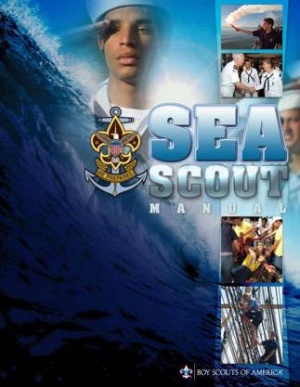
- Sea Scouts, the Coast Guard Auxiliary's Official Youth Program Facebook group is a great place for best-practice discussion of the Auxiliary working with Sea Scouts. Subscribe and stay up-to-date.
-
 Sea Scouts BSA on YouTube
Sea Scouts BSA on YouTube - Sea Scouts BSA
-
 Coast Guard recognizes Sea Scouts for rescue
Coast Guard recognizes Sea Scouts for rescue - Boy Scouts of America
- Scouting magazine
- Florida Sea Base
-
 Sea Scout Safety Moments
Sea Scout Safety Moments - Guide to Safe Scouting
- "Sea Scouts" in Guide to Awards and Insignia
Auxiliary Sea Scout Program Statistics
Visit our Reports page for all the latest information from the program.
